Looking for the best Champagne to elevate your celebrations? In this article, we’ll explore top picks that are perfect for any festive occasion. From understanding the origins to learning about the main grape varieties and regions, we’ll guide you through the essentials of Champagne. Expect to also uncover the art of blending, the differences between vintage and non-vintage options, and tips for proper serving. Whether you’re a seasoned connoisseur or just beginning your Champagne journey, we have something for everyone.
Key Takeaways
The Champagne region’s unique terroirs and primary grape varieties (Pinot Noir, Pinot Meunier, and Chardonnay) contribute distinctive characteristics to the wines, with each district adding its own flavor profiles.
The art of blending different wines and the meticulous second fermentation process, known as méthode champenoise, are essential to creating the unique sparkle and consistent house styles of Champagne.
Vintage Champagne, made from grapes of a specific exceptional year, undergoes longer maturation and is rarer and more expensive, while non-vintage Champagne blends grapes from multiple years to maintain a consistent flavor profile and is more widely produced.
The Origins of Champagne
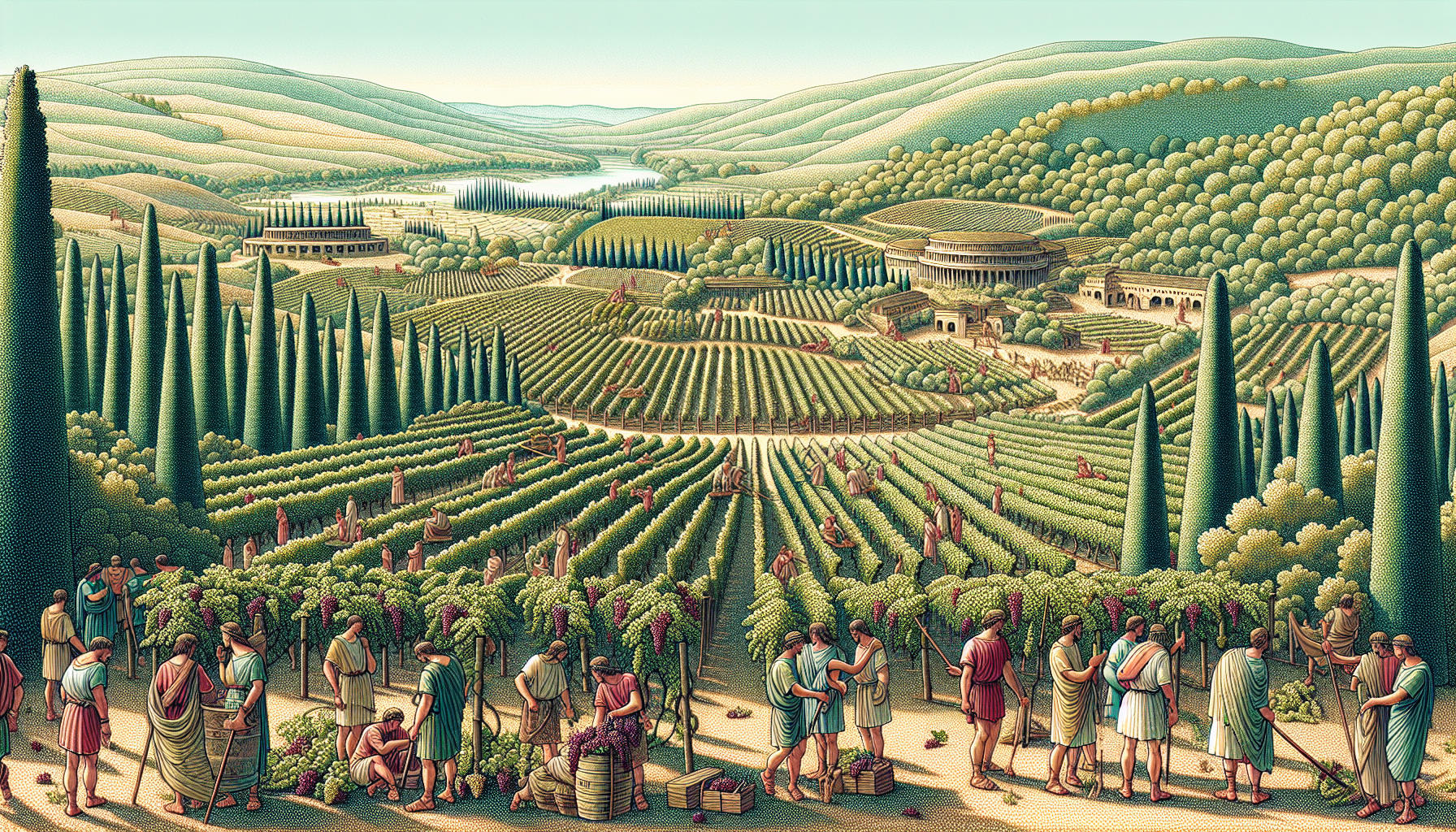
Wine production in the Champagne region has its roots stretching back to when Romans introduced viticulture there in the first century AD. The initial champagne was quite different from modern sparkling wines. By the 9th century, drinking Champagne had come to signify regal elegance and it was commonly enjoyed during coronation ceremonies at Reims Cathedral.
Dom Pérignon, a Benedictine monk from the 17th century, is credited with major advancements that shaped Champagne’s evolution into what we enjoy today. His legacy includes introducing pinot noir grapes and refining methods for inducing secondary fermentation within wine bottles—key steps towards developing effervescent wines. He innovated by devising new stoppers made of hemp, which curtailed instances of bottle shattering common during early stages of sparkling wine manufacturing.
Another notable inventor who contributed substantially to maintaining this bubbly beverage’s integrity was Adolphe Jacquesson. He designed a wire hood that proved effective in keeping corks affixed tightly on champagne bottles, reducing incidents involving catastrophic eruptions considerably. In consequence, by the endowment of such innovations throughout history until as late as in the 18th-century era, when multiple celebrities embraced these fizzy drinks—the endowment of such innovations throughout history.Champagne established itself profoundly linked with extravagance and fame across continents.
Although associated predominantly with grandeur due largely to historical consumption patterns amongst nobility spanning centuries past including high societal affairs, it’s also emblematic for peace amidst formerly strife-stricken lands where initially vineyards came forth under Roman dominion now known universally famous for their unique sparking concoction: Champagne.
Champagne Region and Terroir
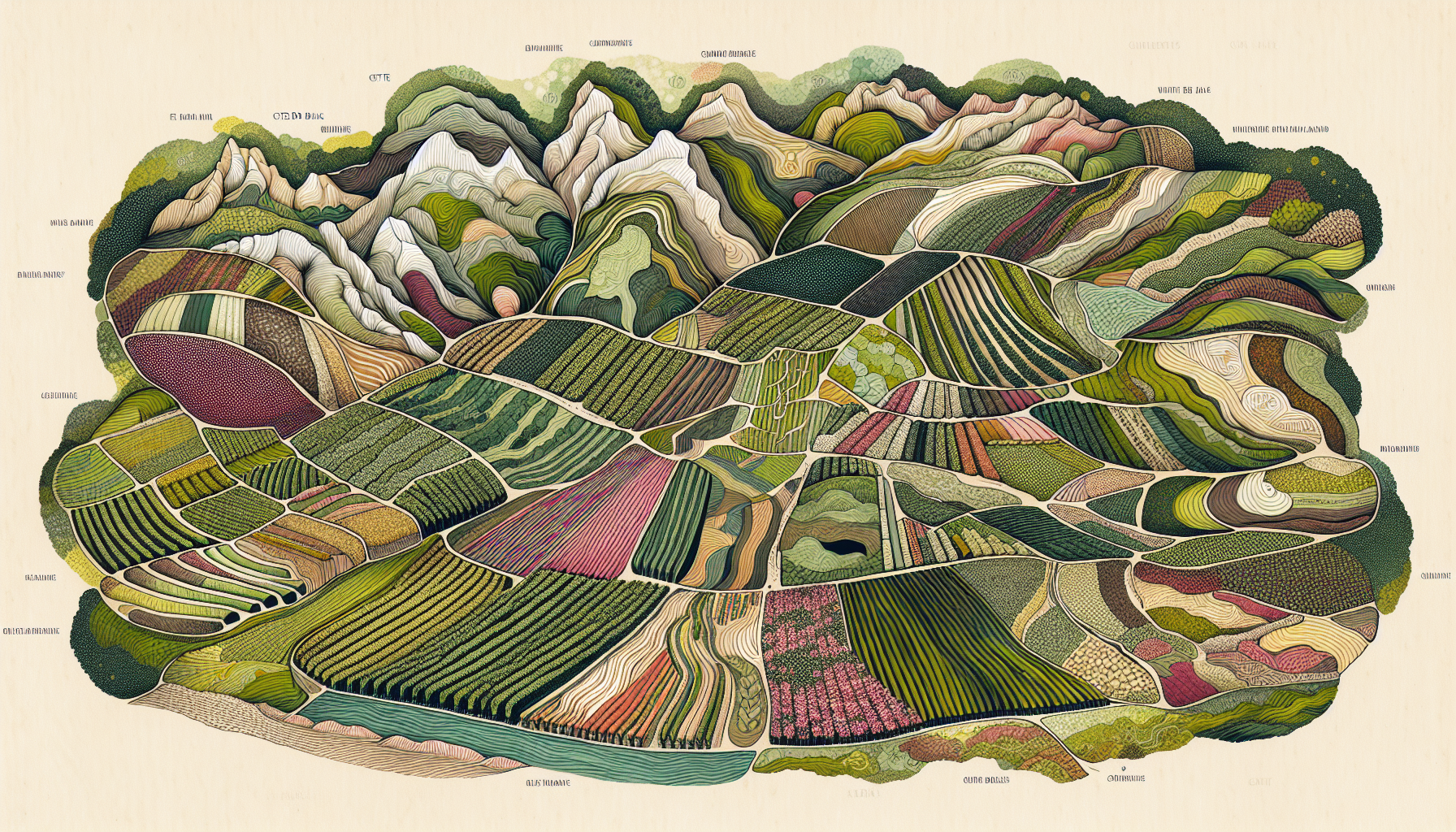
The sparkling wines produced in the Champagne region emerge from five principal districts, each imparting distinctive qualities to these esteemed beverages. The Montagne de Reims is particularly noted for its varied terrains featuring limestone clay and chalk-rich soils that are well-suited for growing Pinot Noir grapes. These factors result in robust, complex sparkling wines distinguished by their pronounced depth of flavor.
In contrast, the Vallée de la Marne district excels in cultivating Pinot Meunier grapes amidst conditions susceptible to frost. This challenge begets some of the most exquisite wines—especially those hailing from villages such as A and Hautvillers—with Pinot Meunier lending a fruity zest and commendable acidity that contribute substantially to the wine’s harmony.
Meanwhile, Côte des Blancs is revered for its east-facing slopes covered with limestone soils where Chardonnay grape vines thrive. It produces refined wines characterized by their elegance and subtlety. Complementing these regions are areas like Côte des Bar—a zone known for producing fruit-forward Pinots—and Côte de Sézanne, which serves as an extension to Côte des Blancs but stands out because Chardonnays there often lead to gentler, more mellow expressions of this celebrated wine variety.
Main Grape Varieties Used in Champagne
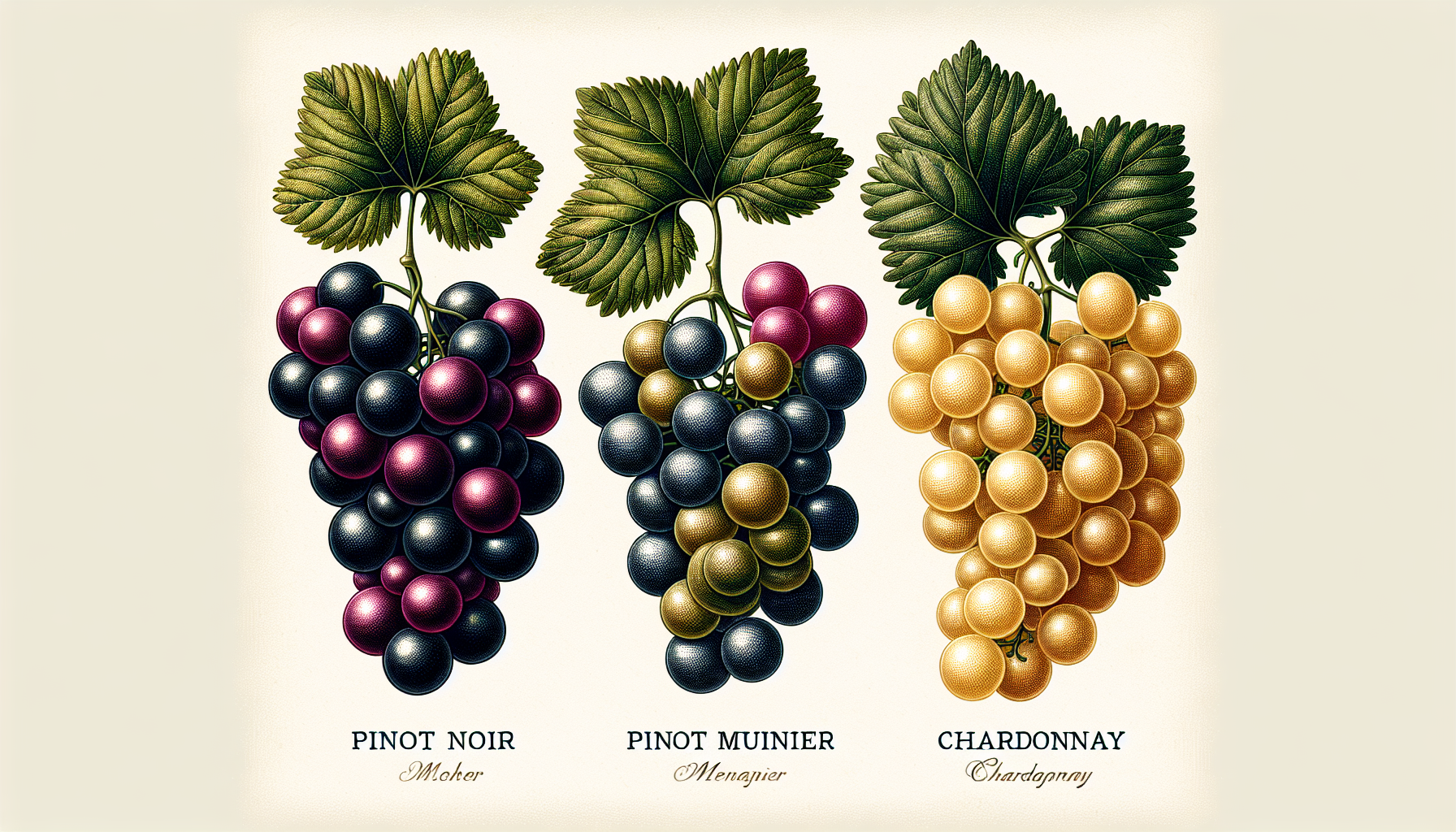
The production of Champagne features three main grape varieties.
Pinot Noir encompasses 38% of planting area in the Champagne region, with a significant presence in both Montagne de Reims and Côte des Bar. Growing well on the cool chalky terrain, it bestows body and notes of dark fruit upon the finished wine.
With 32% vineyard coverage, Pinot Meunier flourishes chiefly within Vallée de la Marne. It endows wines with an array of fruity and floral scents.
Occupying about 30% of the cultivable land for this purpose is Chardonnay which is predominantly planted across Côte des Blancs. This variety imbues the wine with a vibrant freshness, sophisticated charm, as well as hints of citrus.
Combined, these varietals infuse Champagne with its distinct flavor profile and characteristics that distinguish it globally.
In particular, Chardonnay claims around one-third (31%) of viticultural space allocated to vines throughout Champage’s lands. Its home turf being primarily located in Côte des Blancs where lies perfection by imbibing effervescent creations grace,liveliness,and aromatic bouquets reminiscent succulent stone fruits especially conducive limestone-abundant areas thereabouts.
The third key varietal contributing to champagne has always been revered not only performance under frosts likely encountered rather frequently amongst hillsides found along banks bustling river coursing right throughValléeMarne. Its fortitude against chilling temperatures comes without sacrificing vivacity or verve typically anticipated within each bottle bubbly produced thus conjoining seamlessly other two aforementioned types form complex alluring taste profiles championed name ‘Champagne.’
The Art of Blending and Production Process
The composition of Champagne is a key element in its creation, providing the ability for producers to craft a consistent house style that captures their unique signature. During January, detailed tastings are conducted by both cellar masters and oenologists as they carefully blend various wines. These blends typically incorporate reserve wines from prior years which help to impart smoothness and maintain consistency within non-vintage Champagnes.
Champagne owes its distinctive effervescence to a two-stage fermentation process — an adaptation necessitated by the region’s harsh winters. The wine, following initial blending efforts, undergoes this crucial second fermentation right in the bottle with added yeast and sugar facilitating bubble production. This exacting approach referred to as both traditional method or méthode champenoise distinguishes true Champagne from other sparkling varieties worldwide.
An additional integral step in ensuring Champagne maintains its esteemed quality involves cold stabilization. It chills down blended wines, preventing tartrate crystal formation, thus safeguarding clarity and stability of the final product. Moreover, ‘dosage’ marks a later stage where select mixes of still wine coupled with sugar determine Champagne’s ultimate sweetness level post-production.
Vintage vs. Non-Vintage Champagne
For those who take a keen interest in the nuances of Champagne, it is crucial to distinguish between vintage and non-vintage varieties. A vintage Champagne originates from grapes all harvested within the same exceptional year determined by champagne houses. The aging process for these wines extends over at least three years, fostering an intricate bouquet of flavors and scents.
On the other hand, non-vintage Champagne blends grapes from various harvests with the aim to achieve a uniform taste across different batches. Such Champagnes undergo maturation for no less than 15 months—a factor that contributes to their relative affordability—and they represent about 90% of total champagne production. When serving, temperatures should be kept around 8o C (46.4o F) for non-vintage bottles, while vintage bottles should be slightly warmer at 10o C (50o F), allowing them to fully express their elaborate character.
Vintage champagnes are acknowledged treasures among sparkling wines. Created only in select instances—typically three or four times per decade—they come with specific attributes:
Exclusive limited releases
Longer cellar ageing requirements
Elevated costs reflecting their rarity
Esteemed regard within wine enthusiast circles
Understanding Champagne Labels
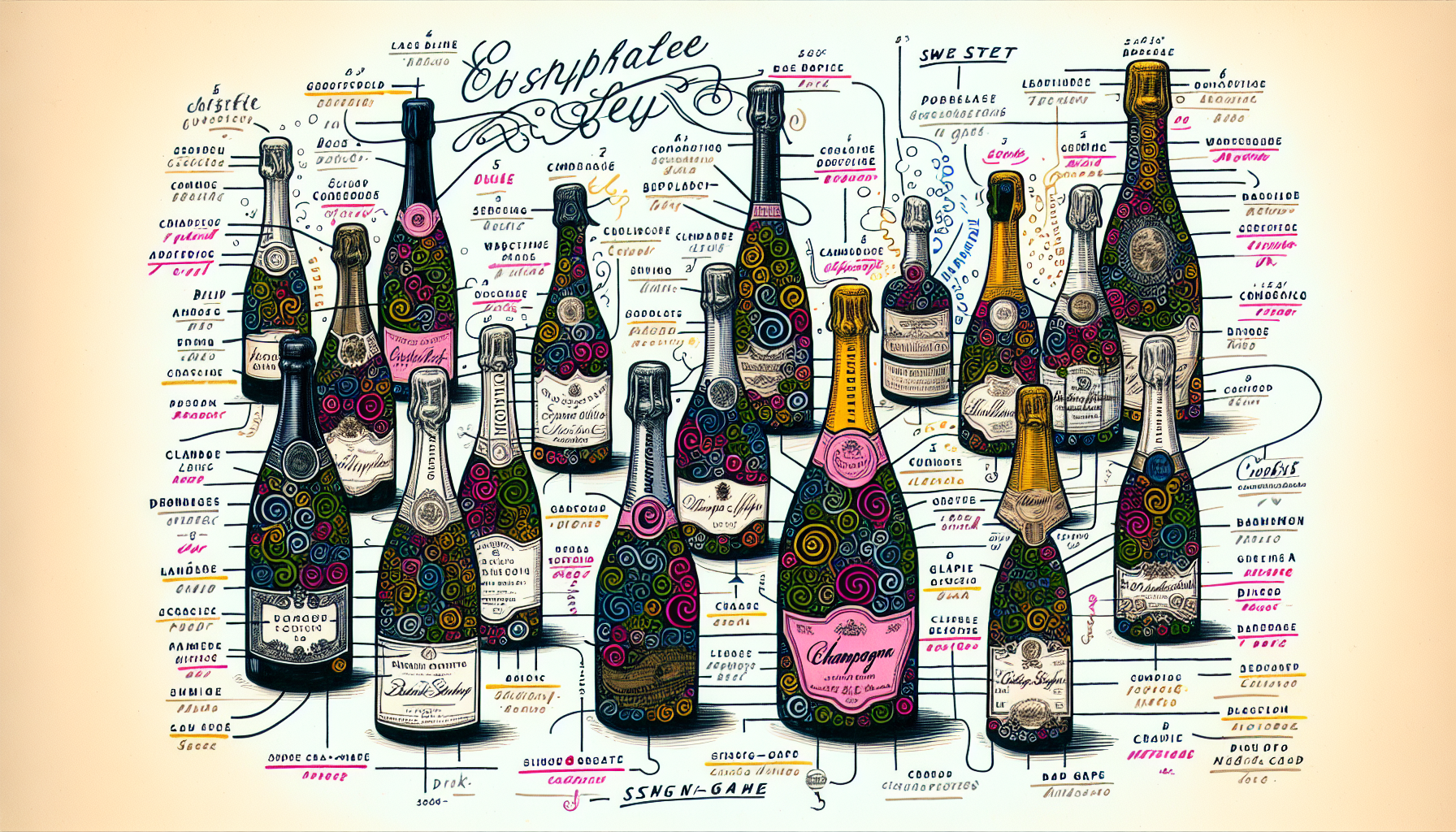
Decoding Champagne labels can be both fascinating and complex. The amount of sugar added during production, known as the ‘dose’, determines the sweetness level of Champagne. Labels like ‘Brut’ indicate a dry Champagne with a small amount of added sugar, while ‘Extra Brut’ signifies an even drier taste with less sugar added.
Terms like ‘Blanc de Blancs’ and ‘Blanc de Noirs’ provide insights into the grape compositions. ‘Blanc de Blancs’ means the Champagne is made exclusively from Chardonnay grapes, offering a light and elegant profile. On the other hand, ‘Blanc de Noirs’ indicates the Champagne is made from dark-skinned grapes like Pinot Noir and/or Pinot Meunier, resulting in a richer and more robust flavor.
Understanding these labels not only enhances your purchasing decisions, but also deepens your appreciation for the craftsmanship and diversity of the Champagne appellation.
How to Properly Serve Champagne
Properly serving Champagne can greatly enhance the enjoyment of this prestigious beverage. Avoid freezing the bottle as a method to chill it, since doing so could be risky and might disturb the delicate balance of its flavors. When selecting glassware, opt for a tulip-shaped champagne glass. Its design promotes effervescence and helps in capturing the essence of aromas.
The act of uncorking a bottle of Champagne should be performed with finesse. While holding onto the cork firmly, gradually twist the bottom at an inclination until you hear a subtle pop—or rather, whisper—which conserves more carbonation and maintains wine quality.
Pouring Champagne calls for skill: grasp it from underneath while ensuring that your guests are able to view the label facing them is considered proper etiquette. To help prevent any potential slip-ups with handling. By adopting these specific techniques when serving, each flute filled will deliver peak satisfaction from your thoughtful presentation.
Food Pairings for Champagne
Champagne’s adaptability makes it an impeccable match for a vast array of culinary delights, adding an elevated touch to holiday feasts and distinguished events. Its vibrant acidity creates a harmonious contrast when enjoyed with smoked salmon blinis, seamlessly slicing through the creamy texture of cream cheese. This classic combination has become synonymous with celebratory moments.
For entrees that are particularly sumptuous, such as lobster, a robust vintage Blanc de Blancs Champagne can Accentuate the opulent taste notes inherent in the shellfish. In similar fashion, Rosé Champagne offers outstanding flexibility and is superbly paired with duck preparations accented by blackberry or cherry sauces.
When faced with richer fare like pâté or strong-flavored cheeses on your charcuterie selection, Sec Champagne provides just enough sweetness to balance out these intense flavors pleasantly. And if you’re indulgent in desserts such as lemon drizzle cake or strawberry shortcake, extra brut Champagnes bring forward their fruity yet rich profiles for an exquisite culmination to any meal.
Rosé Champagne: A Growing Trend
The allure of rosé champagne continues to capture the attention of wine lovers around the globe. It has been a significant part of wine culture since its early production in 1734, with Champagne Ruinart being an inaugural maker. As evidence of its growing appeal, by 2015, sales for rosé champagne represented 12% of the total champagne market and have enjoyed an annual growth rate averaging at 3.6% starting from 2005.
This surge in popularity is largely thanks to consumers becoming more knowledgeable about wines and having greater access to a diverse range of high-quality rosés. The Modern, which boasts two Michelin stars in New York City, experienced a substantial uptick in their sale of Rosé Champagnes—seeing an increase as much as 20% within one year alone—which mirrors a wider acknowledgement and celebration for what makes Rosé Champagne distinct.
Solidifying itself beyond just passing fancy or seasonal preference is how well Ros&eaute,e,(ae)mpagne endures factors such as fluctuations in price points.r sees heightened interest no matterthe hour;aurenith unrping roleuntrybingl-)using bio-friendly processes that carefil resonatingptionsfficientingwaysredients potential on long-term value innureheartsuilt-in love story intertwined every bottle rouge blisseful sip..
Notable Champagne Brands and Producers
Several iconic Champagne brands and producers, each with unique offerings, have established a distinct identity in the industry. Veuve Clicquot, established in 1772, is famous for its ‘Yellow Label’ and the innovative riddling technique developed by Barbe-Nicole Ponsardin. This technique revolutionized the way Champagne is produced and enjoyed.
Mot & Chandon, founded in 1743, is another legendary name, renowned for its extensive vineyards and iconic ‘Mot Impérial’ vintage. Nicolas Feuillatte, a cooperative Champagne house founded in 1976, brings together over 4,500 independent winegrowers, making it a significant player in the Champagne industry.
Other notable brands include:
Mumm, known for its ‘Cordon Rouge’ and association with Formula 1 as an official sponsor
Piper-Heidsieck, famous for its ‘Cuvée Brut’ and ‘Rosé Sauvage’
Lanson
Taittinger
Laurent-Perrier
Each of these brands offers distinct styles and flavors that cater to diverse palates, contributing to the rich tapestry of Champagne producers.
Alternatives to Champagne
The Champagne region has a special status in the world of sparkling wine, yet there are numerous other wines that can provide comparable satisfaction and complexity. For example, Cava from Spain is made with indigenous grape varieties like Macabeo, Parellada, and Xarello using the champagne method also known as the traditional method. These Spanish counterparts to champagne wines present themselves as bottled sparklers noted for their zesty and invigorating character.
There are an array of excellent alternatives available to those who appreciate Champagne.
Italy’s Prosecco boasts light-bodied and fruity nuances
Cava from Spain shares its creation process with sparkling champagnes through the traditional technique
Franciacorta also hails from Italy. Crafted predominantly from Pinot Blanc along with Chardonnay, it exudes sophistication and layered tastes.
Crémant signifies a collection of French effervescent wines produced beyond the bounds of Champagne but utilizing identical age-old methods—these come in assorted flavors accommodating diverse preferences.
Not to be overlooked is South Africa’s Méthode Cap Classique, which mirrors the time-honored champagne approach resulting in effervescent wines that stand toe-to-toe with premier Champagnes regarding caliber and palate experience. Diving into these substitutions can expand horizons for aficionados seeking variety within premium bubbly libations.
Celebrating with Champagne
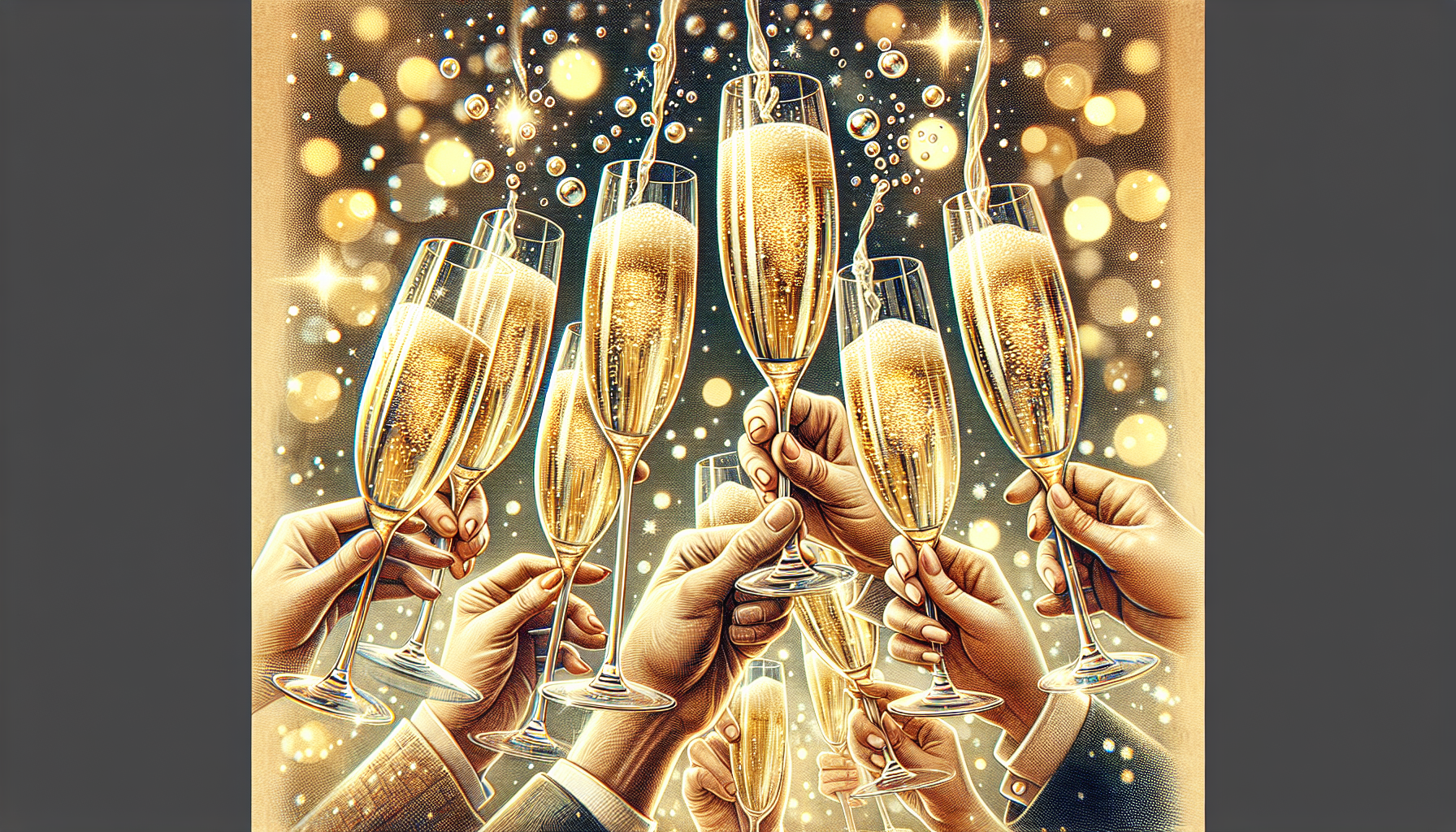
Champagne embodies more than just a beverage. It is an emblem of luxury, joy, and the sophistication associated with French culture. Its role in grand ceremonies such as feasts, historic signings, and high-society gatherings has solidified its position as the consummate drink for celebrations. When raising a toast to commemorate weddings, anniversaries or professional accomplishments, Champagne lends an air of refinement to these momentous events.
This effervescent wine has been a muse for creatives from various disciplines, which only adds to its global repute and connection with elegance. From the lively bubbles ascending through champagne glasses to the intricate flavors that unravel on one’s taste buds—from the lively bubbles ascending through champagne glasses to the intricate flavors that unravel on one’s taste buds.Chapmagne captures both exuberance for life and luxurious festivity.
With each burst of cork followed by cheers echoing off clinking glassware, there lies shared elation and glory within those interactions. So remember when you find yourself marking milestones over flutes filled with pink champagne —let Champagne stand as your celebratory confidant transforming precious moments into memories that last forever.
Summary
The illustrious background of Champagne, its distinct production techniques, and its role as an emblem of festivity and opulence endow it with an enduring allure. Tracing back to the era of the Romans through to its aristocratic heritage and advancements by individuals like Dom Pérignon, Champagne has consistently transformed. Its complexity and sophistication are a product of both the unique soils found within the Champagne region and principal grape types such as Pinot Noir, Chardonnay, and Pinot Meunier.
Delving into vintage versus non-vintage Champagnes improves your understanding while learning how best to present this renowned sparkling wine elevates your experience. Whether enjoying food pairings, indulging in Rosé Champagne or examining alternatives such as Cava or Franciacorta—the unmatched choice for commemorating extraordinary moments is invariably Champagne. Thus, let us lift our tulip glasses in a salute to the perpetual splendor that is synonymous with every glass of rosé wine from this storied region.
Frequently Asked Questions
What is the difference between vintage and non-vintage Champagne?
Champagne labeled as vintage is crafted from grapes all gathered in a particularly outstanding year and is required to age for no less than three years. Conversely, non-vintage Champagne combines grapes harvested across various years to sustain a uniform taste profile and must undergo maturation for at least 15 months.
These aging requirements yield unique taste characteristics distinctive to each category of Champagne—vintage and non-vintage alike.
What are the primary grape varieties used in Champagne production?
Pinot Noir, Pinot Meunier, and Chardonnay are the fundamental grape varieties employed in creating Champagne. They each bestow unique qualities that enhance the wine’s intricate complexity.
How should Champagne be served for the best experience?
For the best experience, serve Champagne in a tulip glass to concentrate the aromas and carefully open the bottle by holding the cork and rotating the bottle to produce a light sound.
When pouring, hold the bottle by its bottom, ensuring the label faces your guests.
What food pairs well with Champagne?
A range of dishes complements Champagne effectively, encompassing everything from smoked salmon blinis and lobster to duck recipes, pâté, cheese platters, as well as sweets such as lemon drizzle cake.
What are some notable Champagne brands and their unique offerings?
Among the distinguished champagne brands with their signature creations are Veuve Clicquot, known for its ‘Yellow Label’ and pioneering riddling method. Mot & Chandon with its celebrated ‘Mot Impérial’; as well as Laurent-Perrier famed for Rosé Saignée Champagne. Other noteworthy labels like Nicolas Feuillatte, Mumm, Piper-Heidsieck, Lanson, and Taittinger also present a variety of unique styles and tastes within their offerings.
Buy Champagne wine below.
Wine Quick Filter
Price
Selected filters
Showing 1 to 20 of 59 (3 Pages)




















